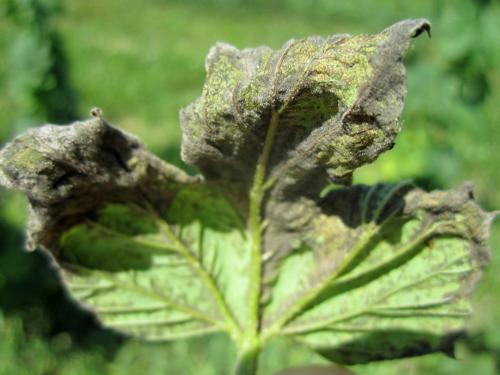Last month, we talked about the devastating impact of powdery mildew on hops, and the registration of flutianil to control it. We don’t typically address the same crop two months in a row, but since this is the crop responsible for great beer, we figured another round would be welcome. So this month, we’ll turn our attention to downy mildew on hops.
“The downy mildew pathogen appears as fluffy dark sporulation on the underside of leaves,” explains Kathryn Homa, a biologist in plant pathology at IR-4 Headquarters. “This is different from powdery mildew, which is typically observed as a whitish powdery substance on the upper or lower surface of the leaves. Their similarity is that they both attack the leaves. And as the severity increases, necrotic spotting and death of the leaves can occur if the pathogen is not controlled.”
Both mildews are more prevalent in areas with high humidity. But Homa notes that “downy mildew favors mild temperatures and leaf wetness for infection to take place.”
Unsurprisingly, hops grown in humid climates including the Midwest and Northeast are particularly susceptible to downy mildew. In fact, according to New Jersey extension agents Michelle Infante-Casella and William Bamka, “Downy mildew is one of the factors (in addition to prohibition) that contributed to driving large-scale commercial hops production from New York State to the Pacific Northwest.”
But downy mildew can thrive anywhere where wet conditions exist. So no hop yard is completely safe from this destructive oomycete pathogen.
Downy mildew has the potential to cause 100 percent crop loss in a very short time—something I witnessed in an entire bed of basil. One day it was flourishing. I could almost taste the pesto. A few days later? It was dead.
“That’s how quick it is,” Homa says. “It just destroys the crop within a very short period of time.”
Growers need a multifaceted approach to battle a pest this persistent. With the Section 3 registration of fluopicolide, they have one more tool in their Integrated Pest Management (IPM) arsenal.

“Fluopicolide is another mode of action for downy mildew control with protective and curative activity,” Homa explains.
Previously, fluopicolide was registered as a Section 18 emergency exemption. “Section 18s are issued when there’s nothing else registered to control a pest that is destroying a crop,” explains Homa. “The EPA will set a temporary tolerance for the use once they’ve made an assessment of its safety.”
A permanent registration of its use depends on conducting a magnitude of residue study to determine actual tolerance levels. “This is where IR-4 came in,” she adds. With IR-4 residue data, a Section 3 federal label was registered for fluopicolide on hops.
“It went from a Section 18 Emergency Exemption to a Section 3 federally registered use,” Homa says. “And that couldn’t have been done without IR-4, because we focus on the minor and specialty crops that others might not focus on.”
Ann George, executive director of Hop Growers of America, grew up on a mint farm in Oregon. She says that in her experience with these two minor crops, there have been a lot of parallels. But hops is in a league of its own.
“Hops is such a small crop but it’s so international,” says George. “And we have a pretty large fan base. Sometimes I think back: if I did this work in the mint industry, would I have this level of support from, say, toothpaste users? I don’t know! [laughs] It wouldn’t be nearly as fun to do trade shows, I’ll tell you that.”
Because hops is such an international crop, it’s essential that products approved for growers are harmonized for use elsewhere, since, as George illustrates, “A hop produced in country A may go through country B, C and D to get to country E, where it’s ultimately added to beer. And then that beer may get shipped to country F.”
All of that travel explains why, as she says, “The US hop industry has had an aggressive international harmonization effort since about 1990.
“We export over 60 percent of our crop every year and one-third of those exports go into the EU. Some of it stays there for use by EU brewers, and a lot is transshipped to other customer areas worldwide.” Either way, “It still has to meet EU MRLs (maximum residue limits).”
She adds that “the US and Germany produce nearly 80 percent of the world’s hops. We have to be able to ship our hops to virtually any country on the planet. And we’re seeing more and more countries start to implement their own positive list systems. So as that happens in countries that are big customers for us, we need to start tracking those MRLs.”
While Germany had previously registered fluopicolide for use on hops, they were unable to use the product on the majority of their hops because the US—Germany’s largest trading partner—lacked a registration for fluopicolide. Now, MRLs can be harmonized between the EU and the US for this chemistry.
Oktoberfest may be canceled this year. Nevertheless, hops growers and beer lovers still have plenty to celebrate.
PR# 10916 Hops (Downy Mildew)
Katie Chriest is a freelance technical writer in Erie, Pennsylvania; kmc503@psu.edu.
